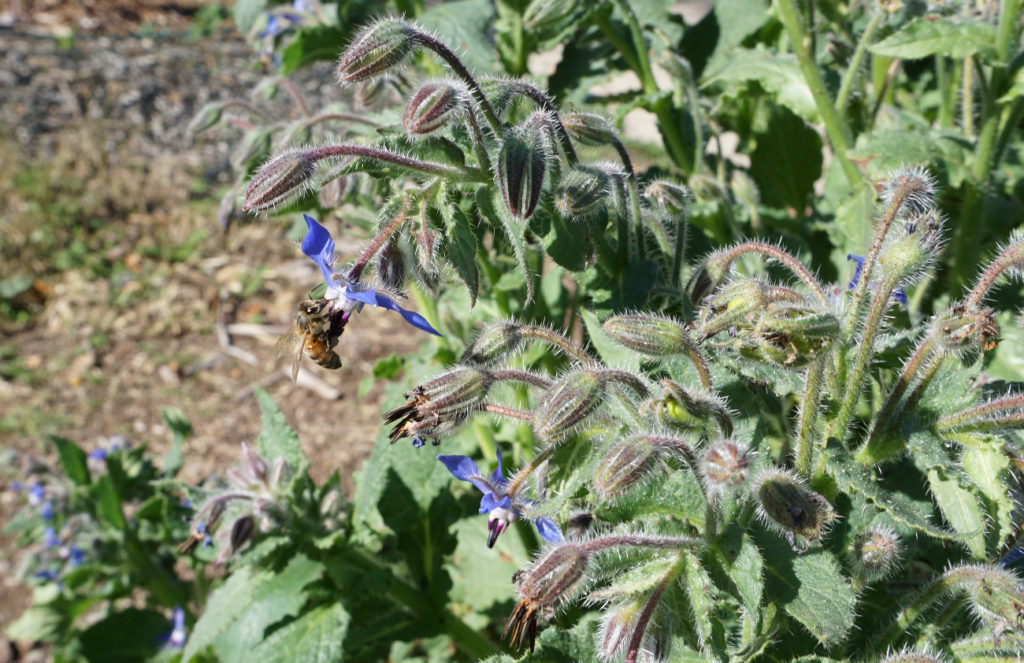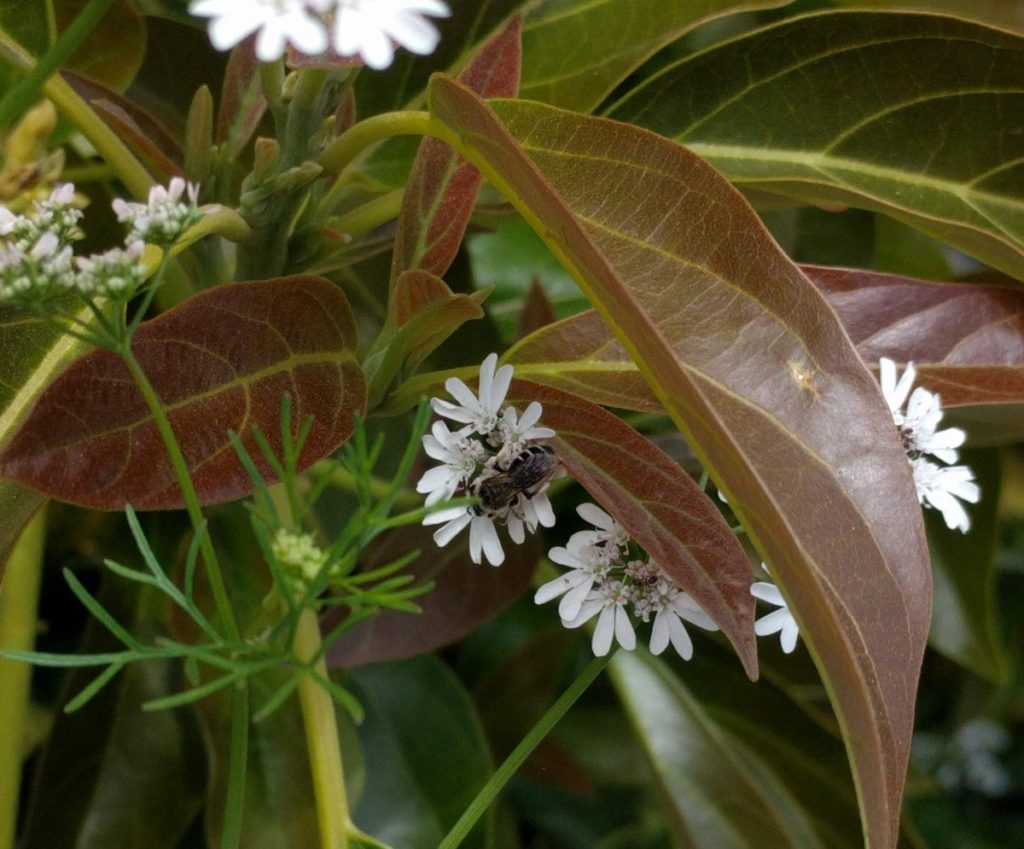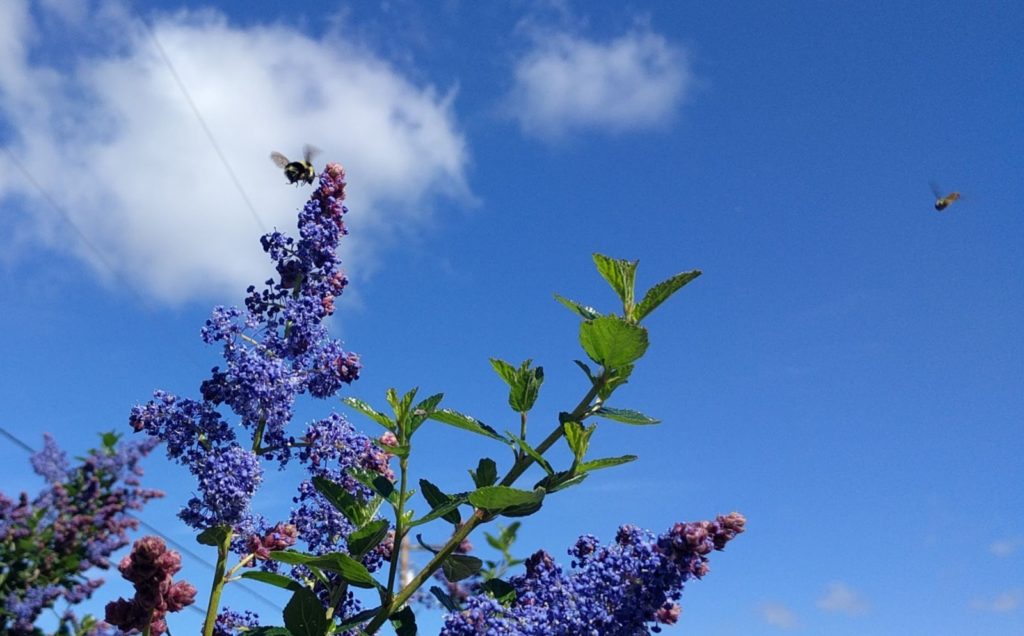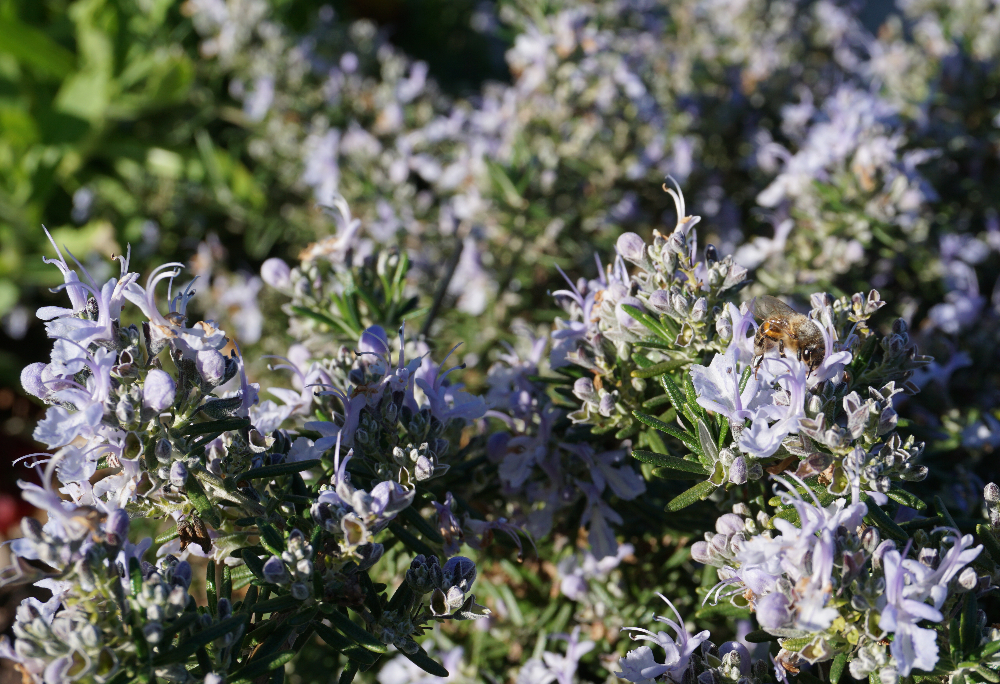For several years, I have recorded which flowers I see bees feeding on in my yard and elsewhere in Southern California, as well as the dates I see them. For example, this month I noted that there are many bees visiting the flowers of my bolted greens (above).
Below is a list that I compiled based on these notes. Month by month, it shows which flowering plants that I’ve seen many bees consistently feeding on.
Flowers for bees in each month of the year in Southern California
January: blueberry, borage, encelia, gaillardia, lavender, manzanita, mustard, rosemary, salvia chamaedryoides, sugar bush
February: blueberry, borage, ceanothus, encelia, gaillardia, lavender, mustard, poppy, rosemary, sugar bush
March: blueberry, borage, ceanothus, encelia, filaree, gaillardia, lavender, poppy, mustard, stone fruit trees
April: avocados, blueberry, borage, ceanothus, citrus trees, encelia, gaillardia, gilia, lavender, monkey flowers, phacelia tanacetifolia, poppy, stone fruit trees, woolly blue curls
May: black sage, gilia, lavender, monkey flowers, phacelia tanacetifolia, sunflowers, woolly blue curls
June: buckwheat, coreopsis, oregano, sumac, sunflowers, woolly blue curls, phacelia cicutaria
July: buckwheat, oregano, sunflowers
August: buckwheat, sunflowers
September: buckwheat, sunflowers
October: buckwheat, cosmos, coyote bush, gaillardia
November: borage, coreopsis, cosmos, gaillardia, lavender, oregano, rosemary
December: borage, coreopsis, gaillardia, lavender, oregano, rosemary

Full names of some plants
Here are the full names, scientific names, other names, and cultivar names of some of the plants in the list:
lavender is Lavandula x intermedia ‘Provence’ and ‘Goodwin Creek’
gaillardia is Gaillardia pulchella
encelia is Encelia californica, also called California coast sunflower or bush sunflower
salvia chamaedryoides is also called Germander sage
sugar bush is Rhus ovata
borage is Borago officinalis
ceanothus is ‘Julia Phelps’ and ‘South Coast Blue’ and ‘Ray Hartman’
filaree is different species of Erodium; it’s a weed, but the bees do love it
black sage is Salvia mellifera
woolly blue curls is Trichostema lanatum
monkey flowers is Mimulus aurantiacus or Diplacus aurantiacus
buckwheat is Eriogonum fasciculatum
cosmos is Cosmos bipinnatus
gilia is Gilia capitata
coyote bush is Baccharis pilularis
rosemary is Rosmarinus officinalis ‘Prostrate’
coreopsis is Coreopsis lanceolata
poppies is Eschscholzia californica
sunflowers is Helianthus annuus (‘Lemon Queen’ is a good one for bees but so are many others)
oregano is ? (I don’t know which kind of oregano is in my yard, but I’ve seen that lots of different types of oregano appeal to bees so it probably isn’t important)
cilantro is Coriandrum sativum

A couple notes about the list
Often, due to the weather of a particular year or a yard’s location, these plants can be in bloom and attractive to bees in other months as well.
In addition to bees, these flowering plants are almost all used by other beneficial insects. What do I mean by beneficial insects? I’m talking about insects that prey on other bugs that can be pests to our plants. I’m talking about beneficial insects like syrphid flies (hover flies) and lady bugs.

(See my post about how syrphid flies protect our citrus trees: “Citrus, ants, and HLB: the latest research.”)
What’s the point of this list?
As you know, bees are vital to the production of most fruits and vegetables. Without their pollination activities, many of our food-garden plants would not produce. And in order to ensure that bees have a high presence in our gardens and groves we should provide food for them. What is food for bees? Flowers. The pollen and nectar of flowers.
In order to have the highest number of bees and diversity of types of bees, there must be plenty in bloom in our yards (or our neighborhood) all year long. So if you notice a period of time where there’s nothing for the bees to eat in the area, refer to the list and plant to fill that gap.
Last year, I noticed that I didn’t have as many flowers for bees as I thought I should through the late fall and early winter so I planted more lavender and rosemary and encelia and borage.
Now here in late January, exactly one year later, these new plants are finally providing dividends. Some are just starting to bloom whereas others have been in profuse bloom for months already. It is working!

Your contribution
Can you add to the list? Which other plants have you noticed bees heavily feeding on in a particular month? I know there are many others that I haven’t listed.
More bees and flowers posts
Check out these related posts I’ve written:
“Growing a bee garden in Southern California.”
“California Bees and Blooms: a book review.”
“Oh, the mistakes I’ve made: Thinking flowers were for girls.”
“Coyote bush for bees in October”
“Bees on flowers in Southern California”
“Ceanothus: blue bush on the hills”
“Monkey flowers: native plant for bees”
“Woolly blue curls: native plant for bees”
All of my Yard Posts are listed HERE
I make these Yard Posts for you, and I appreciate your support so I can continue.




We always let at least one artichoke fruit (?) go to flower all the way for the bees. And this month they are loving the broccoli I set aside to let flower. Thanks for the info, concern, and protection of our bees!
I like that, Christine! Artichoke flowers are gorgeous too.
Thanks for all the Bee flower ideas…l’ll try some of them. I have found that the Iceland Poppy I grow during the colder months (in Irvine) really attract the Bees. They seem to go wild over them and spend a lot of time gathering the pollen.
Check out African Blue Basil, it’s quite a bee magnet! Incredibly fragrant & attractive, it’s a perennial hybrid variety that’s also sterile. I’ve got some planted in an orchard. They are thriving and grow large, also survived temps into the low 20’s. We’ll worth adding to any pollinator garden.
Thanks for reminding me of that plant, Kevin. I remember them having a large patch of it at Cal Poly Pomona a few Augusts ago, and it was covered in bees.
Eucalyptus in December.
Macadamia, April I think.
Palm trees, no particular month. I have a few common species and they like them all.
Fennel (typically summer) and arugula (year round) are favorites too.
Hi Val,
So true that when a big eucalyptus is in bloom it sounds like a hurricane with all the bees that arrive to feed on the flowers.
Reading your posts from my Greek garden with a similar climate. This time of year the bees are swarming around our Tecoma capensis – and I guess American bees would like it too? If you grow it there… And probably they like your native Tecomas too?
You’re right, Christina. Some people call it Cape honeysuckle here. I had a giant hedge of it at my previous property, but in my memory I associate it more with hummingbirds because that’s who I noticed visiting it the most. Maybe that’s because I want as attuned to bees back then.
Can you tell me which bee friendly flowering plants will not be eaten by rabbits?
Hi Dave,
Rabbits don’t seem to be attracted to most of the plants on my list, but I have gotten into the habit of protecting newly planted ceanothus and sunflowers because rabbits do nibble on those often. I use chicken wire cylinders until the plants’ stems get about an inch in diameter.
Thanks Greg, love your blog. Your info is so helpful.
I planted many squash specifically because the bees love the flowers but unfortunately they are infested with fungus gnats and bees are not going anywhere near them. Is there anything I can do to get rid of the gnats?
My California pepper trees have so many bees on them that you can hear them humming from far away. They appear to be starting their bloom right now.
What a great reminder, bees are vital! It’s a good list, and I just want to give a shout out to a white sage, Salvia apiana-they named it after bees (bees love all sages). I bought a plant at a native plant sale with the common name of “bee plant” and sure enough, they loved the blooms. It’s also known as California Figwort, Scrophularia californica. I’ve noticed bees in the leaves of coast live oaks, I think early mornings in summer. Maybe the oaks exude some moisture that the bees use? Two other thoughts: bees like a steady reliable water source which can be as simple as a bird bath (using non-chlorinated water). Also, though it is completely artificial, bees will make use of a hummingbird feeder. I have one that seems to leak slightly and the bees cluster on the bottom, lapping up the sugar water, while the hummingbirds come to the normal supply points on the sides. Anything to help out…
Thanks for all the great ideas, Doug. It might be that the bees are feeding on the coast live oak flowers, which are easily unnoticed. They are very small, relatively long, and yellow.
Speaking of water, it seems that native bees don’t need a water source in the same way that European honey bees do. Apparently, they get enough water from the nectar of the flowers they feed on.
But I have noticed that some of the types of native bees that build nests in the dirt are attracted to spots where the dirt is wet. I have a faucet where we often wash our hands and the bare dirt below is frequently moist through summer, and I notice many holes from ground-nesting bees there.
I learned about borage from my mom. She cooks it like one would cook spinach. Also, if you pull the flowers carefully, just taking the petals, and put them on a salad, they taste like cucumber. All that and they bring tons of bees.
Hi Bob,
Last week someone told me he eats bougainvillea flowers and then he added them to a smoothie he made for me. I had no idea.
Now you’re telling me I can eat borage too. It’s crazy that I’m 45 and still learning that I can eat plants that I’ve been surrounded by my whole life!
I have a ton of gaillardia that seems to be thriving in my hot, dry, non irrigated front yard. I’m happy to know it’s so good for the bees!
Hi Greg,
Since we have a similar climate here in the Algarve (Portugal) I list some of what we got here now. We got fields and fields of sour grass (oxalis). Extremely invasive plant and very annoying weed for gardeners grr, but bees seem to love them. Some fields are just plain yellow from so many flowers.
Otherwise, aside from the usual suspects, which many you mentioned, I noticed that the bees seem to like my jade plants pretty much, which are now fully covered with flowers. Gazanias don’t seem to be their favorite meal but sometimes there’s some around (I got a rosemary nearby them so it’s hard to beat that extraordinary bee magnet).
Regarding trees, there’s still not much going on, although some peach and plum trees are starting to bloom, with strawberry trees (arbutus) in flowering season and specially the spectacular flowering almond trees they got some work to do till the full season kicks in.
Lastly, just as a curiosity I have a chicory -belgian endive- flowering for months. I had some that I’ve grown for winter consumption (unrooted and replanted them in a bin so they can grow in the dark to get those tasty white leaves) but left one for seeds and the striking blue flowers seem to attract them also.
What about basin sage for your list?
Greg, yes bees love the yellow flowers of mustards. But what brings masses of bees in our gardens (home and our teaching garden) is the Thai basil. They swarm that plant, so that I have some concern that they actually neglect to visit other plants’ flowers. Someone should set up a camera and watch if they move on to other plants.
Regards,
Florence Nishida
Master Gardener, founder of LA Green Grounds.org
Thanks for this, Florence. I remember seeing bees all over a patch of Thai basil at Cal Poly Pomona one August a few years back. I’m going to plant some this year when it warms up.
Don’t forget Rosmarinus officinalis, huge bee attractant winter through spring and again in fall. Super adaptable and water wise and many cultivars for the growth size and habit needed. We have ‘Huntington Carpet’ selection, the bees swarm over it and are so happy😀.
Hi Audrey,
You’re so right, but I didn’t forget rosemary! It’s on the list, and it’s the last photo in the post. Every yard should have some rosemary: for the bees, and because it needs next to zero irrigation, it smells great, and you can use it in cooking. What’s not to love?
Hi Audrey,
I did list rosemary for November through February, but you are right that its bloom season is longer. Honey bees are all over my rosemary here at the beginning of October.
‘Huntington Carpet’ looks like a type that I would like too; I prefer the low-growing ones.
Yes, I was just noticing today how many honey bees were on my rosemary plants. A tidbit of information on rooting. Cut 5-6” long tips and place in water on an east facing window sill. The fragrance is so pleasant & voila in a few weeks you will notice white roots emerging. These cuttings can then be transferred to a pot or the ground. ‘Huntington Carpet’ is a selection from the Huntington Botanic Gardens in San Marino. I have plants over 30 years old and lightly hedge them once a year to maintain a height of 18”. Great water wise plant too!
Rosemary grows and attracts hoards of bees in Northern California. They buzz from December well into summer. Mexican sage also does great up here.
One of my favorites is a version of oregano called “hot and spicy”. It flowers from Feb all through the spring. And it is tongue numbingly hot. Maybe not as easy to grow as the standard stuff, but well worth it.
There’s also the burpee pollinator mix. Nice, diverse set of flowers that pop in the spring. I plant some in containers and some sewn wild in the general avo tree area. Note that they don’t sell the early bloom pack in Ca. There must be an invasive species in the mix.
Anise Hyssop is a bee favorite here in Topanga Canyon (90290) and I’ve watched the bees go back and forth between it and the perennial African Blue Basil. And on hikes I’ve noticed Deer Weed in bloom with plenty of bee visitors. The local Sugar Bush blooms twice a year.
Bees in Irvine are crazy about peppermint. Some say it’s a pernicious weed but it’s been around in my yard for years and I haven’t had a problem. This year I watered and fertilized two patches and the bees have been drinking nectar for most of summer. I drilled a few holes in a log and put it in a dry place to see if wild bees use it.
I also grow African Blue Basil. this plant is constantly growing flowers and is a bee magnet. I have even taken cuttings so I do not run out.
Several years ago I let a couple of broccoli plants bolt to get seeds. I was amazed at the number of bees and butterflies that were attracted to the broccoli blossoms. Now I always allow one or two plants to bolt just for the bees. We also have a bush labeled “Mexican sage” that bees, butterflies, and humming-birds love; it blooms year-round.
Thank you for this month to month flowering list! So helpful. And I love to hear a fellow gardener in their simplicity… observing nature and feeding their family <3
The loquats are filled with bees right now in November and December– A must fruit tree to grow very easily from seed. Bares in three years if you take care of it. And it’s not a heavy fertilizer or water need tree like avocados.
Poppies are a great bee 🐝 attractor . Bees swarm on the flowers for a couple of days until the petals fall off. I will just throw some seeds around my garden and then thin them out if I have too many I plant them in October then they seem to start growing around now in January through February. I have tons of beautiful flowers in the backyard.
I let a Calabrese Broccoli, an heirloom variety, bolt and flower. It continued to grow and flower all summer and fall. Now in December, it’s about four feet tall and wide and has hundreds of flowers. Bees love broccoli flowers, as shown in your first photo!